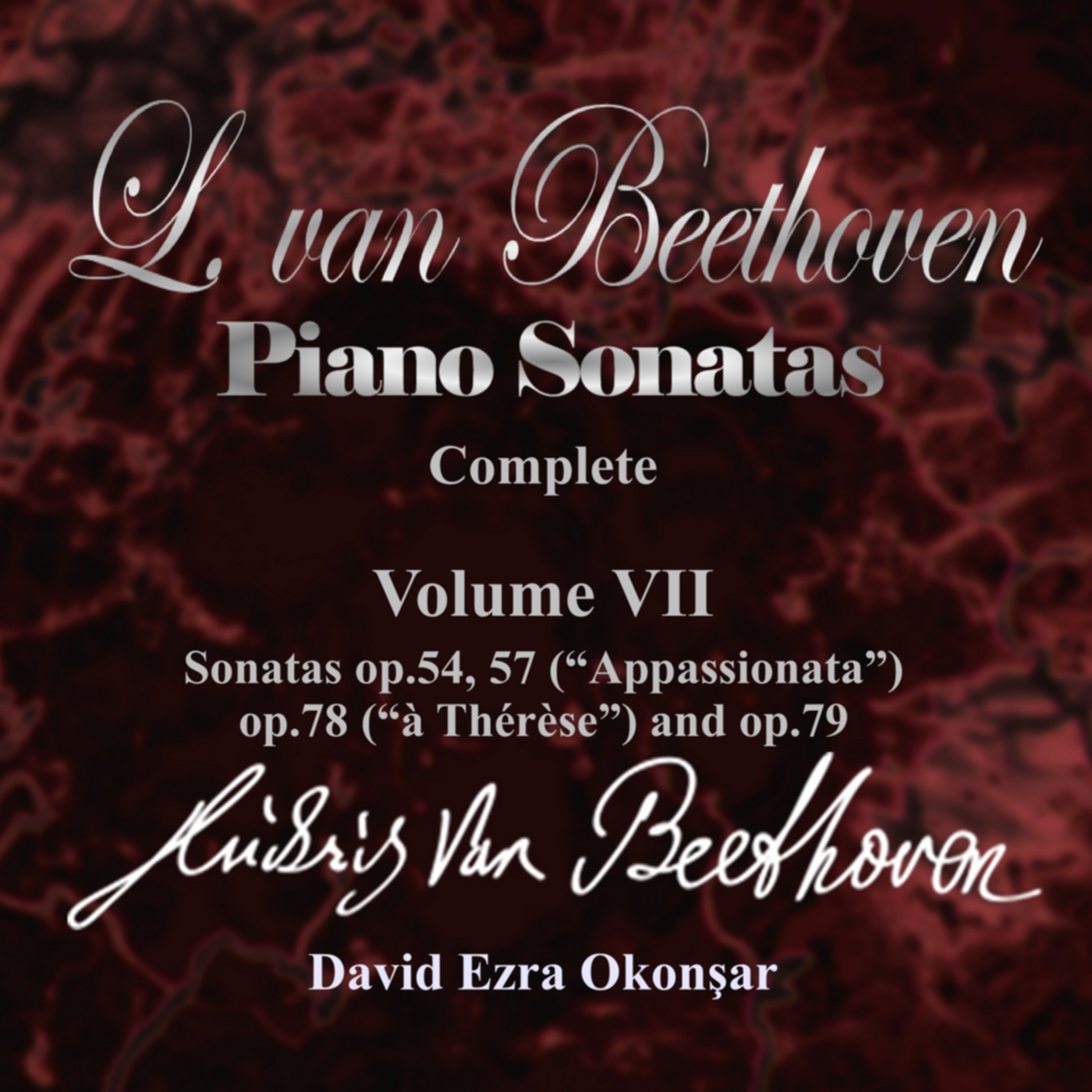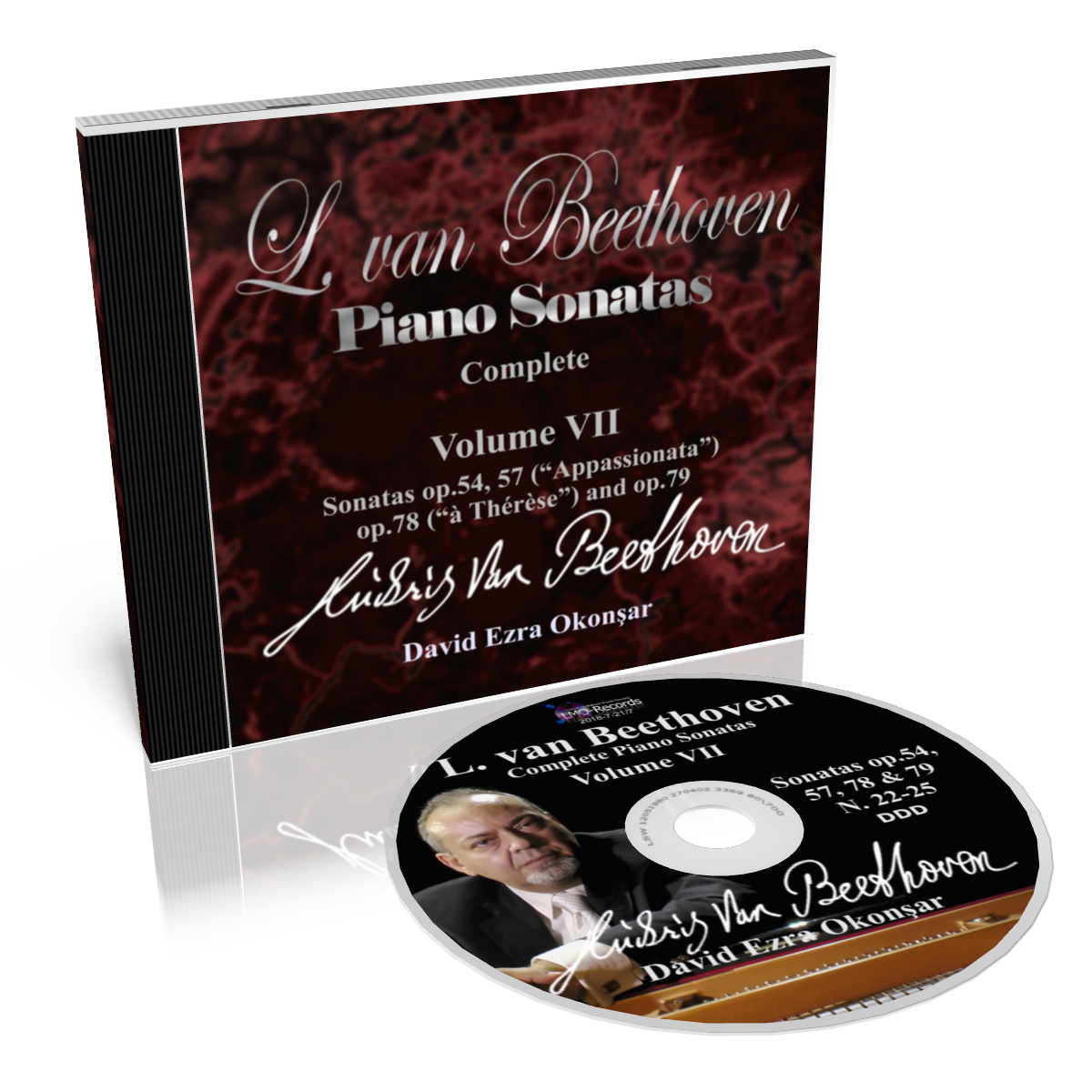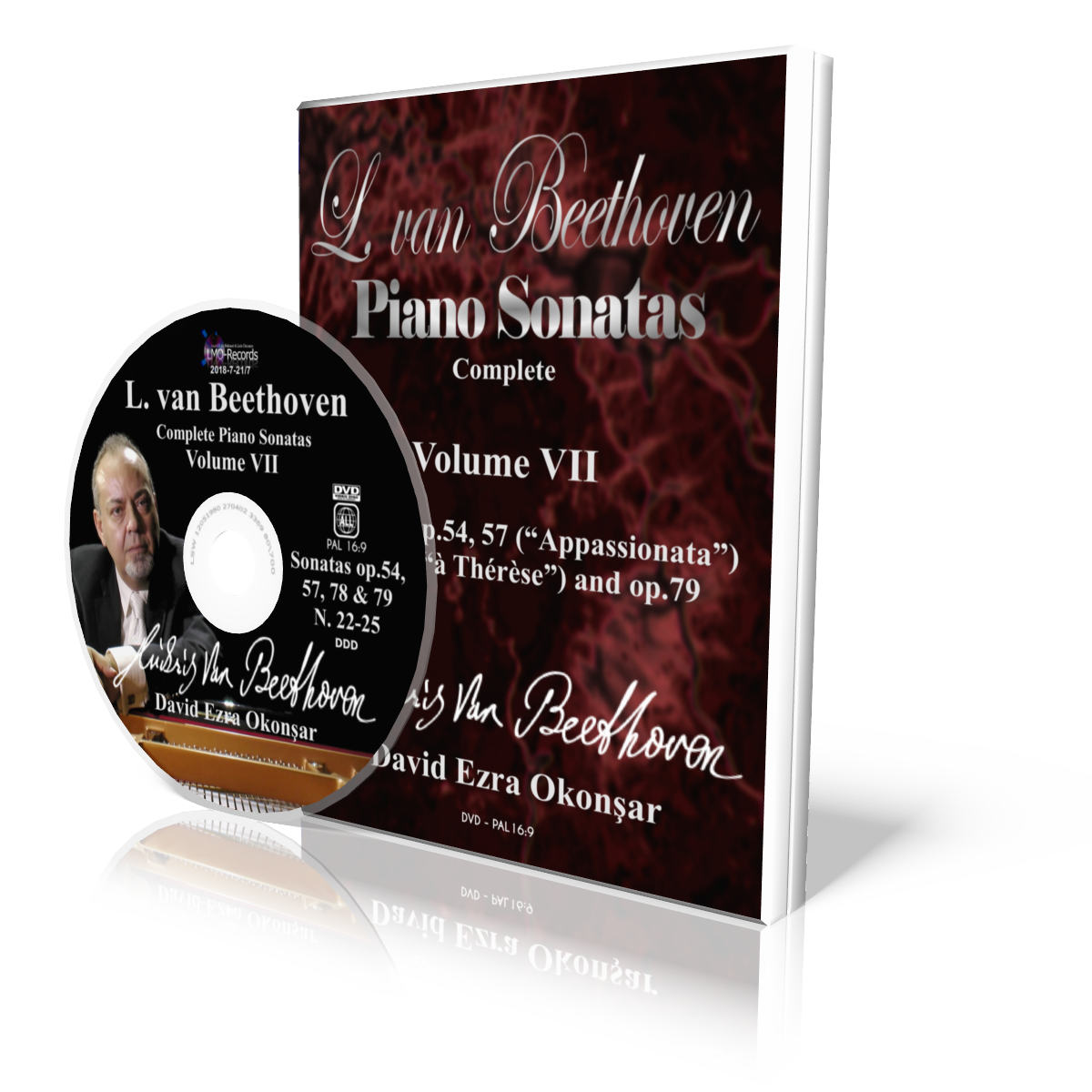
Piano Sonatas
Sonata No.22 in F Major, Op.54
Sonata No. 23 in F minor, Op. 57 ("Appassionata")
Sonata No. 24 in F-sharp Major, Op. 78 ("A Thérèse")
Sonata No. 25 in G major, Op. 79
Volume 7 of the series:
The Complete Piano Sonatas by Ludwig van Beethoven



|
Sonata N.22 in F major op.54 Between the widely popular opus 53 "Waldstein" and opus 57 "Appassionata", this Sonata seems left on the sidelines. Some authors called it feeble, for others it was no less than a failure (!). However, it is one of the most interesting, intriguing sonatas of this so-called second period of Beethoven. Breaking with all the conventions, even those established by the composer himself, the two movements of this concise Sonata defy analysis. It was composed in 1804 and published by the "Comptoir des Arts et de l'Industrie" (Vienna) in 1806, this very particular Sonata was greeted by this strange review in the "Allgemeine Musikalische Zeitung": "the two movements of this Sonata evokes the song of crickets". Bizarre evocations did not stop there. Taking into account the strongly opposed two themes of the first movement, the Swiss musicologist Richard Rosenberg suggested the story of the "La Belle et la Bête" (Beauty and the Beast) as a common thread and has justified the unusual proceedings of the first movement by the characteristics of this narrative. Paul Badura-Skoda and Alfred Brendel often referred to this analyze. Even though any analysis should attempt to be inspiring and not be cold and dry, some of those pursuits of bonding a literary story over a purely musical form must be taken with caution. I would refer more to the musical text of those two short movements, separated only with a double barline in the original manuscript. I. In tempo d'un menuetto Definitely not a Menuet, this indication "In tempo .." refers not only to the time signature but more to a certain agogic very characteristic of the old dance form. Actually one may see in it more a kind of Rondo with variations. With the advent of the totally contrasting second theme, in octaves, a label like "menuet in the Sonata form" may seem less ironic than it appears. The delicate theme of this "pseudo-Menuet" is harmonized rather strangely making use of the second degree 7th. chord, very rare in the classical harmonic patterns, specially in the beginning of a piece. Also to note is the wide span of the melody. II.Allegretto - Più allegro The movement, with its two-voice setting and relentless pace in sixteenth notes is comparable to a perpetuum mobile or to a Toccata. It has a sophisticated harmonic design and proceeds with elaborated modulations in its development part. Starting at bar 45, Beethoven wanders all through the keys in the cycle of fifths with great poise. Sonata No. 23 in F minor op.57 ("Appassionata") Sketched in 1804, simultaneously with the Heroic Symphony during a summer spent in Döbling, the Sonata N.23 was finished probably before or at last in 1806. It is first published in 1807, the title "Appassionata" was given later, apparently with the consent of the composer, in a second publication by the publisher Cranz in Hamburg. Carl Czerny states that except for the last five sonatas, Appassionata was the sonata Beethoven himself looked as his best. The pictorial phrase: "A stream of fire [running] in a bed of granite." worded by Romain Rolland is inspired by Beethoven's phrase: "read the Tempest by Shakespeare.." regarding the Sonata op.31 N.3. Roland pursues: "What is the overall \i Stimmung of this Sonata ["Tempest, op.31 N.3]? Battering of essential impulses, passions, frenzy of people and nature with regard to the domination of the mind. Isn't it not precisely the definition of the art of Beethoven in this state of maturity?" With that much humanism in it, since its publication this Sonata was always one of the most popular, played and loved ones. I. Allegro assai The first movement is built on two themes generated from the same rhythmical cell. Both themes share the same dramatic stress. The impulses created by the first theme which is an arpeggio of the tonic chord of F minor, same notes as in the theme of the Sonata N.1, op.3 N.1, also in F minor, are broken by long trills followed by silences with \i fermatas added. Hands in unison, but two octaves apart create a very unique sonority, most of the dramatic soundscape is in that particular sound having a strange "emptiness" in the center. To be also noted is the rhythm as notated: a quarter tied to a 16th. note followed by a 16th. note in Allegro assai tempo at 12/8. Often, this very intense, razor-blade sharp and dramatic rhythm gets softened by careless interpreters who probably attempt to "create an atmosphere" by slowing it, and they turn the incisive 16th. note into something like an 8th. note, thus alleviating the full line. Most of the exposition section is as if the momentum could not start with full energy. The somewhat questioning repeated notes prefigure almost textually the beginning of the Fifth Symphony. "Fate knocking" already? Actually, all drama is made with timbral characteristics, incomplete harmonies, unison (octave) settings, brisk opposition of "pp" and "ff", dispersion in far areas of the keyboard, silences, broken lines, fermatas... With this work, Beethoven not only mastered all possible sound effects of the (relatively new-born) instrument but transcended them and expanded its possibilities to areas never explored before. The second theme, in A-flat major opposes the serenity of this very placid and harmonious key, together with its own legato and cantabile aspect; yet the original nervousness persists by the use of the same rhythmic setting mentioned above. The first movement has its own final section, Più Allegro, the struggle is then at its most violent phase. The eloquence of the end of this movement is unique. The first theme roams almost all through the keyboard and ends its journey at the lowest note of the keyboards of that time the low F. II. Andante con moto The slow movement looks like a variations set but it is not indicated as such. A homophonic écriture creates a hymn-like environment, in D-flat major with a very stable harmonic language. It is a sort of "consolation" between the first and last movements. The proceedings of the movement is a gradual animation of the lines from syncopated eight notes to sixteenths and thirty-two's as well as a progressive raise of the music towards the treble range accompanied with a continuous boost of the dynamics up to fortissimo. The ascend of hope and optimism? A short re-exposition of the initial theme will break to a diminished seventh chord, first pianissimo, then fortissimo, like a tear or a scream. III. Allegro ma non troppo - Presto This same chord that abruptly ended the otherwise peaceful second movement will be ruthlessly repeated thirteen times fortissimo and the sonata-like perpetuum mobile last movement will then start. It must be noted that this movement is indicated Allegro ma non troppo and it is a common but serious error to take it too fast. Also to be noted the analogy between the theme of this movement and the first theme of the first one. Both are made on the favorite arpeggiation figure of F minor, which Beethoven did use in his first sonata (opus 3 N.1) as well. Again, with similarity to the first movement, the ending part (Presto) is an uplifting of the same theme. For this effect to be reflected with accuracy one should be careful about the -ma non troppo indication of the previous Allegro. Sonata No. 24 in F-sharp major op. 78 ("A Thérèse") Three years at last are between the Sonata "à Thérèse" and the previous Appassionata. During those years the fourth piano concerto, the violin concerto, the fifth and sixth symphonies, among other works were born. Beethoven liked very much this "small" sonata. Its title comes from being dedicated to Thérèse von Brunsvik, the Sonata opus 78 was published in 1810 at Breitkopf und Härtel, Leipzig. Its two movements reflect a warm and rich tenderness as well as poetry. I. Adagio cantabile – Allegro ma non troppo About the four bars, Adagio cantabile which serve as an introduction to the Allegro ma non troppo, Hans von Bülow declared: "Beethoven would be immortal even if he did write only those four bars". This should be a very important clue on how to play it. They are not apparently connected in any way to the Allegro which follows. Yet, they set the ground so perfectly that Jörg Demus affirmed: "the most tender letter-head ever written in music". The theme of the movement is presented dolce and understanding the implications that the work is in the rarely used F-sharp major key is of vital importance for the intelligence of the Sonata. II. Allegro vivace Still in the same key of F-sharp major, this is a light and happy game, as the previous movement was deploying loving garlands, this one expands short arabesque-like motives combining light and shiny virtuosity together with some cheekiness. Sonata No. 25 in G major op.79 (1809) Commonly referred to with the descriptive name "alla Tedesca" (in the German [style]) this Sonata was first published as a Sonatine or "easy" sonata by Breitkopf und Härtel in 1810. It is composed right after the previous one but it is based on some early sketches. When Beethoven wrote to his friend Thérèse Malfatti: "you will get shortly some other compositions you'll not regret being too difficult" he probably had this one in mind. However, the apparent ease should not be misleading for the Sonata contains subtle traps for the performer. For more insights into those Sonatas please watch the video "About.." below |
||||
|
|
||||
|



